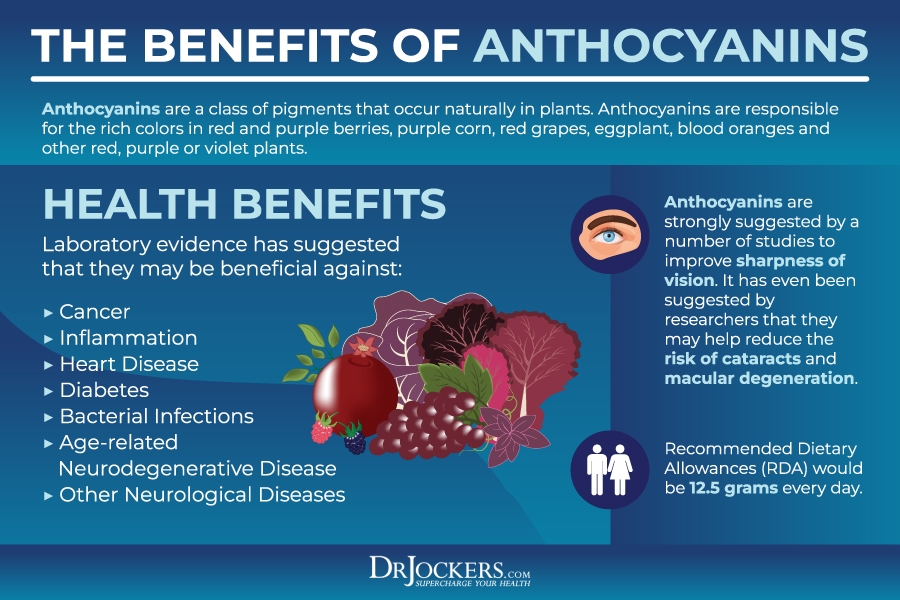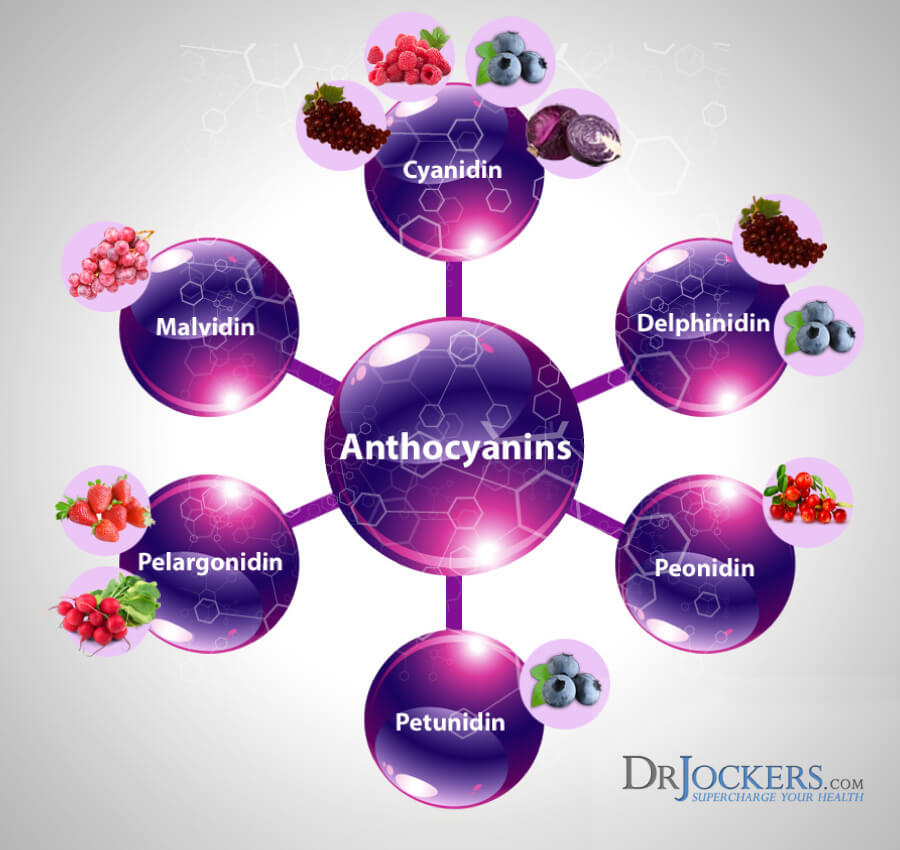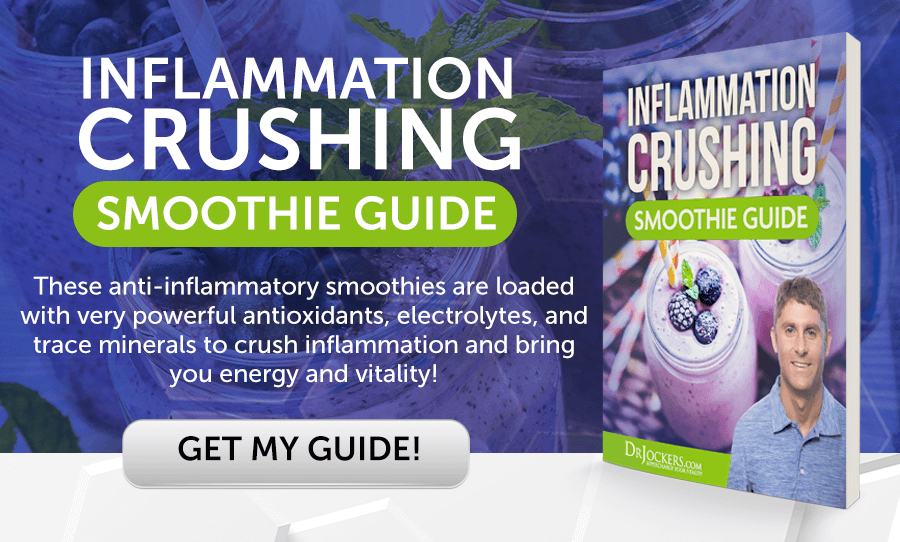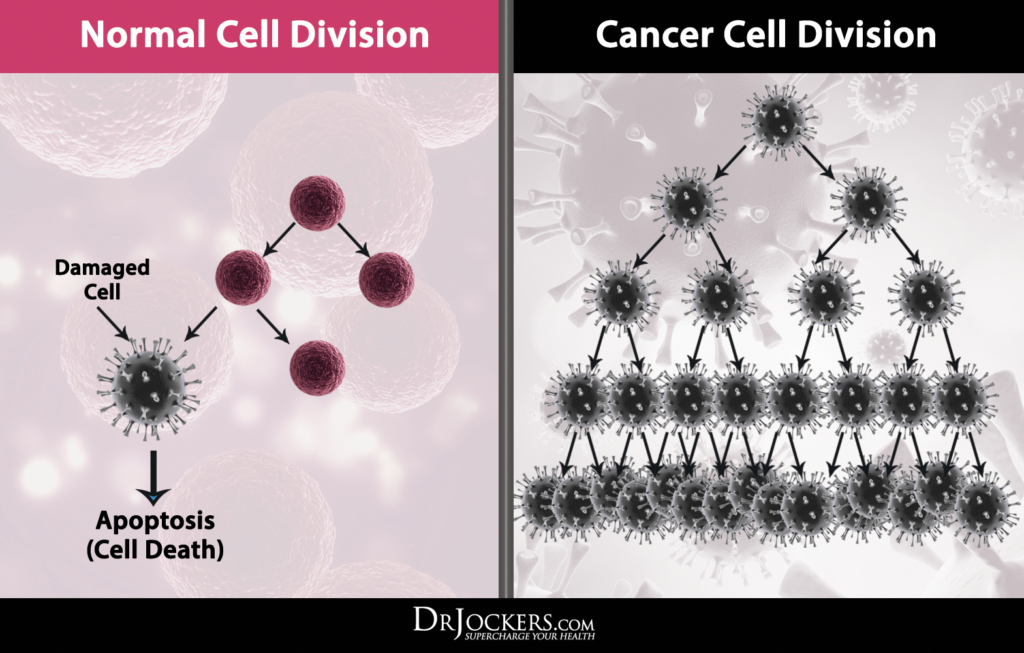The Unique Pigment That Prevents Cancer
Free radical damage is one of the leading causes for accelerated aging and cancer cell formation. When cells are exposed to heavy amounts of free radicals without sufficient cell signaling processes, they develop genetic mutations that replicate abnormally. Antioxidants are nature’s defense against free radicals. Some of nature’s most powerful antioxidants are a class of polyphenols called anthocyanins.
Many plants are exposed to direct sunlight and ultraviolet rays all day long. This constant biological challenge has forced these plants to form powerful free radical scavenging antioxidant polyphenols in order to protect themselves. The anthocyanin class of polyphenols is an especially strong protective component (1).

Prevent Cancer with Anthocyanins
Anthocyanin molecules take their name from their deep blue or purple color. Cyan is the Greek word for dark blue. This color is derived at the cellular level through very unique double bond structures.
These unique components have allowed their host plants to thrive in an environment of direct sunlight by acting as a natural sunscreen through absorbing blue-green and UV light. This process of photo inhibition dramatically reduces stress on the plant. Additionally, these components act as antioxidants with very quick and effective free radical scavenging effects.
Scientists have found over 600 forms of anthocyanins naturally occurring in our ecosystem. The most common form of anthocyanin is cyaniding-3-glucoside (C3G) which has been shown through human and animal studies to directly influence gene expression. C3G has been shown to selectively up-regulate genes that provide more protection while down-regulating genes that cause damage such as pro-inflammatory mediators (1, 2, 3).

Inflammation and Cancer Growth
Most people in our society are chronically inflamed due to excessive free radical formation, lowered antioxidant status, nutritional deficiencies, poor fatty acid balance, elevated toxins, elevated mental & emotional stress, and elevated physical & neurological stress. When these factors are present the body produces higher levels of inflammatory mediators such as cytokines that produce inflammation and tissue damage.
Under inflammatory conditions certain cells will trigger oncogenes which are genes that induce cancer cell reproduction. The greater the acceleration rate of oncogene formation the faster the rate of cancer growth.
Anthocyanins and Cancer
Once a cancer cell gets formed it has a strong potential to spread into local tissue & metastasize into other areas (4). The body’s own natural defense against cancer is programmed cell death called apoptosis (5). Anthocyanins have been found to suppress the inflammatory conditions that create oncogenes while promoting cancer cell apoptosis (6).
Cancer cells are typically in what is called an “undifferentiated” state when they are formed. This means they do not have any specific functional characteristics like a normal liver or skin cell.
C3G has been shown in studies to induce normal differentiation of certain cancers such as melanoma cells (7). This is very important because cancer cells that differentiate are dramatically less dangerous than undifferentiated cells.
Prevent Colorectal Cancer and Diabetes:
Colorectal cancer patients may receive the greatest benefit from the chemotherapeutic properties found in C3G extract (2). Anthocyanins are the dominant antioxidants found in our foods known to prevent and treat cancer. Cancer is a disease of altered metabolism that feeds from faulty energy production.
Type-2 diabetics have high concentrations of circulating free fatty acids associated with obesity and insulin resistance. C3G can regulate and control this metabolic disturbance along with other pathways regulating glucose. Improving the body’s ability to inhibit altered energy pathways limits the occurrence of cancer development and is possible with C3G.

3. Stimulate Cancer Cell Apoptosis:
Previously described, oncogenes prevent inflammatory damage to tissue and supports apoptosis in abnormal cells. One of the most significant realizations involving cancer development is how proper apoptosis pathways have a tremendous ability to suppress malignant cancer growth.
As critical as oncogenes are to defend against cancer cells, oncogenes are also susceptible to genetic mutations. Anthocyanins are crucial compounds needed to prevent cytotoxic damage to oncogenes and support the body’s natural ability to heal. Anthocyanins are one of the best tools to prevent cancer because of this ability to support apoptosis in cancerous cells. (4, 5)
4. Improve Detoxification Pathways:
Feeding the body with anthocyanins equips it with the natural ability to combat all of the hazardous agents which attempt to break down tissue daily. Traditionally, anthocyanins in foods have been used to treat a variety of ailments in herbal medicine including the common cold, liver disorder, infection and high blood pressure.
One likely reason why anthocyanins have such potent anti-inflammatory and chemopreventive properties is due to the ability of this antioxidant to improve blood circulation. (1)
Anthocyanins:
1. Are Found in the Dark Colors Within Fruits and Vegetables
2. Protect Plants from Strong UV Radiation (and our skin)
3. Powerful Antioxidants that Scavenge Free Radicals
4. Reduces Inflammatory Cytokines
5. Suppress oncogene (cancer expression) formation and turn on anti-inflammatory, cell-protective genes
6. Induce normal differentiation of melanoma and other cancer cells
7. Stimulate cancer cell apoptosis (programmed cell death)
Foods Richest in Anthocyanins:
| Food source | Anthocyanin content in mg per 100 g |
| Açaí | 320 |
| Black Currant | 190–270 |
| Aronia | 1,480 |
| Eggplant | 750 |
| Blood orange | ~200 |
| Marion blackberry | 317 |
| Black raspberry | 589 |
| Raspberry | 365 |
| Wild blueberry | 558 |
| Cherry | 350–400 |
| Red Currant | 80–420 |
| Purple corn | 1,642 |
| Purple corn leaves | 10x more than in kernels |
| Concord grape | 326 |
| Norton grape | 888 |
Other great sources include red cabbage, red onion, purple cauliflower, purple broccoli, strawberries, goji berries, red beans, red lentils, etc. Most natural fruits and vegetables with blue, red and purple contain these nutrients. When you cook these at a high temperature you lose much of these precious antioxidants.
Utilize Berries
Incorporating berries into your diet is an excellent strategy to fight cancer with anthocyanins. Berries from fresh off the vine to dried fruit and supplemental form have shown the potential to prevent genetic mutations which cause abnormal cell development (2, 6).
Begin with sautéing some of these purple-colored vegetables, add red cabbage into your sauerkraut and juice your favorite anthocyanin containing foods into your breakfast.

Incorporating Anthocyanins in Your Diet
1. Make a shake everyday with coconut milk and anthocyanin rich berries such as blueberries, raspberries, blackberries, acai berries, elderberries, &/or bilberries.
2. Snack on red cabbage, make red-cabbage sauerkraut, or juice red cabbage.
3. Use exotic foods such as purple cauliflower, purple corn, & purple broccoli and lightly steam them.
The key is to try to get a wide variety of various natural colors into your diet on a daily basis. This provides the greatest flavor, food decor and cancer preventative benefits.
 Inflammation Crushing Ebundle
Inflammation Crushing Ebundle
The Inflammation Crushing Ebundle is designed to help you improve your brain, liver, immune system and discover the healing strategies, foods and recipes to burn fat, reduce inflammation and thrive in life!
As a doctor of natural medicine, I have spent the past 20 years studying the best healing strategies and worked with hundreds of coaching clients, helping them overcome chronic health conditions and optimize their overall health.
In our Inflammation Crushing Ebundle, I have put together my very best strategies to reduce inflammation and optimize your healing potential. Take a look at what you will get inside these valuable guides below!









I am happy I found help to eork on impruoving my health. Thank you very much
Hey Marilda, I am happy you found us!
I would like to know what is the H202+ recipe used in the nebulizer for mucus, etc.,? One person referenced it in her comments.
I am learning a lot from your website and listening to your podcasts. I am wondering if you have any experience with patients and pyoderma gangrenosum?